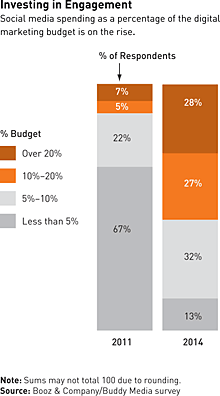Scaling Up Social Media
A survey of senior marketers reveals three capabilities for building better online consumer relationships.
Burberry Group PLC has a rich heritage that would make many other companies envious. For more than 150 years, this luxury apparel company could credit its success to its instantly recognizable brand and timeless yet contemporary designs. But today a new defining element has come to the fore: branded digital and social media experiences. Just look at how dramatically Burberry has reimagined its fashion shows, once effectively off-limits to the brand’s many admirers. Today Burberry streams its shows to its fans on Facebook (12.8 million as of May 2012) and its audience on YouTube (13.3 million unique video views and about 35,000 subscribers to its channel as of May 2012). Partnering with Twitter, the company created the “Tweetwalk,” a real-time feed that showcases new designs just before they hit the runway. This gave Burberry’s Twitter followers (978,000 as of May 2012) unique “see it first” access. By leveraging these platforms, Burberry has turned its fashion shows into content-rich social experiences that engage millions of fans and interested consumers, rather than just a few industry insiders.
With these moves, Burberry has positioned itself on the leading edge of digital and social media. And many other companies are investing similarly in strengthening their social media presence and related capabilities. In the summer and fall of 2011, Booz & Company and Buddy Media, a social enterprise software provider, conducted a quantitative survey of 117 leading companies and a series of in-depth interviews with senior marketing and media executives. The results revealed that strengthening social media is on the CEO’s agenda at 40 percent of responding companies and is a top marketing priority for about 60 percent. Seventy-eight percent believe that social media efforts enhance their marketing effectiveness; 95 percent expect to invest more in social media.
Today, two-thirds of responding companies dedicate 5 percent or less of their digital marketing spending to social media. Within three years, however, 56 percent of responding companies expect to spend 10 percent or more of their digital marketing budgets on social media, and 28 percent expect the figure to exceed 20 percent. (See Exhibit.)
Companies aiming to take full advantage of this expanding social media spending need to scale three important capabilities: community management, content development, and real-time analytics. For innovators like Burberry, these capabilities are most often combined as a mutually reinforcing system operating under the leadership of the marketing function. (In Burberry’s case, the company’s creative and design leadership are involved as well.) Burberry’s deliberate investment in these digitally focused capabilities has enabled the company to develop powerful, direct, and multiplatform relationships with its fans and consumers, creating unprecedented opportunities for brand building, product marketing, and consumer engagement. This strategic focus on digitizing and socializing its brand and the consumer’s experience of it has profoundly changed the company. Says creative director Christopher Bailey, “Burberry is now as much a media-content company as we are a design company.”
Creating a Social Experience
For companies in all sectors, community management, content development, and real-time analytics represent a new way to build direct relationships with consumers — and thus a major opportunity to generate business value.
1. Community management. As companies begin building brands on Facebook pages, Twitter feeds, YouTube channels, Google+ circles, and, most recently, Pinterest boards, they realize quickly that establishing a social media presence is just the beginning. Community management — the art and science of convening and hosting fans in social media across multiple platforms — quickly emerges as a vitally important skill.
This discipline is critical in establishing a social media community that is healthy, active, and growing. Further, once visitors become fans, companies have the responsibility to listen to them and reward their behavior with an “always on” experience. Managing real-time communities requires expertise that includes listening to what fans are saying; curating the editorial experience; ensuring that the brand’s voice and presence are coherent; measuring the effectiveness of the brand campaigns against business and brand objectives; and innovating to anticipate what is next for the brand’s fan base in terms of content, tools, or digital media platforms.
Not surprisingly, these new requirements also raise concerns. About 50 percent of respondents say their lack of sufficient community management resources represents a major barrier to social media success, and 55 percent worry that they are losing control of their brand messages. “You have to be ‘on’ 24/7,” notes a senior executive with a major apparel brand. “You have to respond to customers all the time. Issues escalate so fast, you can be held hostage by someone in social media.”
Many companies are therefore on the hunt to recruit talent that can support high-impact community management. The community management professional, part brand champion, part chief listener, part superfan, and always “mission control,” brings a variety of skills to bear on the job. It is a dynamic, complex, and people-intensive function that requires a fusion of analytic and creative expertise.
2. Content development. To build a robust content development capability, companies must often completely reboot their approaches to communications and campaigns. According to one major beverage marketer, “Old-time brand managers only did TV. Now brand managers have to think about social [media] in everything they do. Do they have sufficient content they can share with their community?”
Unlike traditional advertising content, the goal of which is often awareness or brand recall, social media focuses on sharable, participation-focused content that stimulates conversations and gets the consumer involved in and connected to brand storytelling. A powerful example is Nike’s “The Chance,” a global Facebook and YouTube-centric competition developed by Nike agency AKQA. Over an eight-month period, 75,000 young, undiscovered soccer players from 40 countries competed for a life-changing contract with the Nike Academy. The aspiring athletes were encouraged to enter the competition by promoting themselves with videos and photos to build a fan following. Nike and AKQA zeroed in on the consumer insight that is true for every competitive sport: Athletes want the opportunity to compete at the most elite levels. Social media allowed Nike to take that insight global, transforming it into a compelling digital media experience for millions of athletes. As Ajaz Ahmed, chairman and founder of AKQA, explains, “There was no better way to tell the ‘Just Do It’ story than by empowering people to become better footballers and rewarding the very best.”
Leading social media teams are taking steps to build publisher-like capabilities, competing aggressively for consumers’ attention, engagement, and loyalty with high-value content just as media companies do. Many marketers say they plan to aggressively expand their content development staff. The survey found that among companies with dedicated social media staff, 49 percent have in-house creative talent. Another 35 percent are actively building their content teams. Among those planning to hire social media talent within a year, 72 percent are prioritizing creative resources — producers and editors — above all other needs.
3. Real-time analytics. Marketers increasingly need real-time insight into their audiences and the impact of their content to know whether their social media efforts are on target. Robust, well-structured analytics and metrics are critical to this understanding.
A real-time capability in social media analytics typically matures through four levels, gaining sophistication with each one. Level One is measuring reach. At this stage, marketers understand the social scale of their brands and know how many fans, followers, subscribers, visitors, and views they have. Level Two is tracking engagement. Marketers move beyond counting to analyze the drivers of participation and amplification in online communities and what kinds of sharable content perform best. For example, they study patterns in comments, shares, video plays, registrations, and other user actions. Level Three is analyzing advocacy. Here, marketers identify fan behaviors that are associated with brand commitment, relevance, authority, and social capital, such as writing reviews providing recommendations. The goal here is to know which users drive brand conversations as well as brand perception, and which users are the brand “multipliers” who get other fans and users to participate in brand conversations and who influence brand behavior positively.
Finally, Level Four is calculating the return on investment. The most advanced companies set out to achieve strategic business objectives with their social media analytics. According to the survey, only about 40 percent of companies have metrics in place today to measure ROI-focused key performance indicators, such as purchase intent, leads generated, conversion rates, or actual sales. A few corporate trailblazers are demonstrating already that social media can drive measurable business impact — in other words, they are turning “likes” and “fans” into real value. For example, Wendy Clark, senior vice president for integrated marketing communications and capabilities at Coca-Cola, has shared publicly that the beverage giant’s social media analytic capability is advanced enough to show that Coke social media fans are twice as likely to consume and 10 times as likely to purchase Coke as nonfans are.
Social media represents an enormous opportunity for unfiltered, direct consumer insights into branding, customer service, and product development. Because 56 percent of companies surveyed are investing actively to improve the quality and quantity of these insights from social media, this analytic capability should only grow stronger.
As more companies refine their use of social media, this more dynamic approach to marketing will dramatically transform how they connect their brands with consumers. By developing these distinctive capabilities, companies can not only create rich new social media experiences for their customers but, like Burberry, transform their organizations and unlock market-leading performance.![]()
Reprint No. 00130
Author profiles:
- Christopher Vollmer is a partner with Booz & Company and leads the firm’s global media and entertainment practice, and is based in New York.
- Karen Premo is a principal with Booz & Company’s global media and entertainment practice, and is based in New York.



